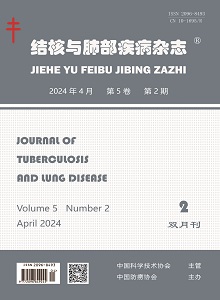-
Clinical observation of patients with acute axcerbation of chronic obstructive pulmonary disease and patients with chronic obstructive pulmonary disease plus community-acquired pneumonia
- ZHU Dan, CHEN Yan, SHUANG Qing-cui, ZENG Hui-hui
-
Journal of Tuberculosis and Lung Disease. 2022, 3(2):
118-124.
doi:10.19983/j.issn.2096-8493.20210166
-
 Abstract
(
182 )
Abstract
(
182 )
 HTML
(
13 )
HTML
(
13 )
 PDF (798KB)
(
100
)
PDF (798KB)
(
100
)
 Save
Save
-
Figures and Tables |
References |
Related Articles |
Metrics
Objective: To compare the clinical manifestations of acute axcerbation of chronic obstructive pulmonary disease (AECOPD) and chronic obstructive pulmonary disease (COPD) plus community-acquired pneumonia (CAP),thus to improve clinical diagnosis and treatment and reduce case fatality rate of them.Methods: We retrospectively collected 101 cases with definite COPD diagnosis hospitalized in Department of Respiratory in The Second Xiangya Hospital of Central South University and The First Hospital of ShaoYang University between January 2017 and June 2017. They were divided into AECOPD group and COPD-CAP group according to their medical histories and results of chest CT examination. The general information, clinical symptoms, signs, inflammation index, nutritional status, and results of blood gas analysis, pulmonary function test results, complications, and clinical outcomes were compared between the two groups.Results: (1) The incidence of chill, fever, lung rales in COPD-CAP group were 15.3% (9/59), 27.1% (19/59), 83.1% (49/59) respectively, which were significant higher than that of AECOPD group (2.4% (1/42), 9.5% (4/42), 64.3% (27/42), χ 2=4.558, 3.448, 11.053, P=0.033, 0.043, 0.037). (2)In the COPD-CAP group, median/mean of CRP, PCT, ESR, BNP and PaCO2 were 34.10 (7.37,79.30) mg/L, 0.17 (0.09,0.25) ng/ml, 32.00 (14.00,53.00)mm/1h、430.00 (140.00,2253.00)pg/ml, and (51.26±16.15)mmHg (1mmHg=0.133kPa) respectively, which were significant higher than that of the AECOPD group ((5.62 (2.94,13.95))mg/L, 0.10 (0.04,0.22)ng/ml, 18.50 (8.00,27.00)mm/1h、150.70 (100.00,547.00)pg/ml, and (45.71±9.94)mmHg, Z=-4.648,P=0.000;Z=-0.818,P=0.024;Z=-3.182,P=0.001;Z=-3.172,P=0.002;t=-3.621,P=0.035). The lung function of the two groups were all abnormally decreased,and the levels of FEV1%pred and FEV1/FVC% in the COPD-CAP group were (45.00±14.70)% and (50.28±7.31)%, which were lower than those in the AECOPD group ((52.02±15.42)%, (61.92±17.92)%), and the differences were statistically significant (t=5.124, 2.726, P=0.000, 0.047). (3) The occurrence rate of heart failure, mechanical ventilation, mortality in COPD-CAP group were 28.8% (17/59), 27.1% (16/59), and 6.8% (4/59),which were significantly higher than the AECOPD group (11.9% (5/42), 9.5% (4/42), 2.4% (1/42), χ2=1.719, 2.824, 0.059, P=0.042, 0.003, 0.027). The average length of stay in COPD-CAP group was (9.38±3.66) days, longer than AECOPD group ((6.28±2.04) days), the difference was statistically significant (t=-1.237,P=0.011).Conclusion: There were differences in clinical symptoms and signs between AECOPD group and COPD-CAP group. Compared with AECOPD group, hospitalized patients in COPD-CAP group got more obvious inflammatory reaction, more severe disease and worse prognosis, thus need to be closely monitored and timely treated in clinic practice.

 Wechat
Wechat